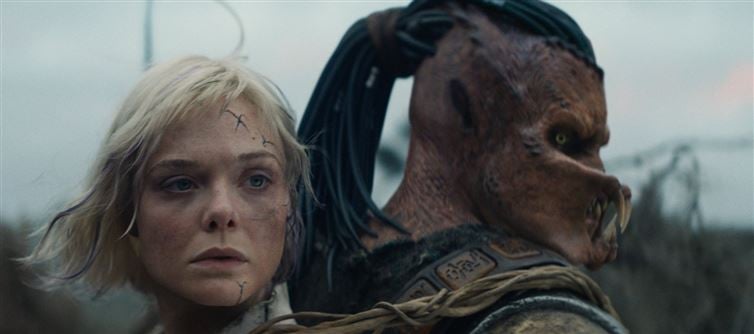
When the hunter becomes the hunted, legends are born.
Dan Trachtenberg’s Predator: Badlands doesn’t just end — it detonates.
In a franchise known for muscle, mud, and mayhem, Badlands dares to do something different: it ends with meaning.
After a vicious two-hour survival odyssey across alien terrain, the film lands a gut-punch of an ending — one that doesn’t just close Dek’s story, but tears open a thousand new possibilities for the Predator and Alien universes alike.
The result? A finale that’s equal parts emotional, mythic, and downright savage — one that cements Badlands as the most franchise-shifting Predator movie since the original.
🩸 1. Dek, Thia & Bud: The New Tribe of Outcasts
The ending of Predator: Badlands gives us the unthinkable — a Predator and a human forming a tribe.
By the final act, Dek (the young Yautja hunter) and Thia (the hardened human survivor) have lost everything — their families, homes, and the illusions that kept them loyal to their people.
But in their shared pain, they find something stronger than blood — honor, empathy, and alliance.
With Bud, the baby Kalisk turned feral companion, the three form a symbolic family — three orphans united by survival rather than species.
It’s a thematic masterstroke by Trachtenberg — turning Predator, a franchise once about domination and death, into a story about connection and defiance.
Dek’s choice to fight with Thia instead of hunting her breaks the sacred Yautja Code — and sets up his exile as a new kind of legend: a Predator who protects instead of preys.
🔥 2. The Final Shot — Who’s Coming for Dek?
That final image — a looming ship descending from the clouds — is pure tension and tease.
Is it Dek’s mother, teased throughout the film as an even deadlier huntress than his father? Or is it the ship belonging to Torres and Kenji, the human survivors from Predator: Killer of Killers?
Either way, Trachtenberg knows what he’s doing — building the first true Predator cinematic universe.
If it’s his mother, then the next film could bring the most dangerous hunt of all: Predator vs Predator, a generational blood war soaked in family betrayal.
If it’s Torres’ ship, we may be seeing the fusion point between Predator and Alien, a crossover decades in the making now housed under the same Disney-owned umbrella.
It’s not just a tease — it’s a declaration.
The hunt isn’t ending. It’s expanding.
🧬 3. The Evolution of Yautja Lore
For the first time in franchise history, Badlands takes us deep into Predator culture — not as faceless hunters, but as beings with beliefs, pain, and internal wars.
We learn the Yautja Codex — a set of brutal commandments: pity is weakness, grief is death, and every hunter must stand alone.
But Dek challenges all of it. He feels grief. He protects. He chooses compassion without losing honor.
That evolution flips decades of Predator mythology on its head.
Instead of another nameless killer cloaked in invisibility, we have a Predator learning humanity — while humans like Thia learn what true honor looks like.
Dek’s final stand isn’t about survival — it’s about rewriting the code.
He becomes an Alpha not by dominance, but by empathy — echoing the wolf-pack wisdom Thia shares with him earlier.
It’s poetic, primal, and beautifully brutal.
⚙️ 4. The Badlands Bridge — Predator Meets Alien
The ending doesn’t just serve Dek’s personal arc; it serves a much bigger purpose — laying the foundation for the Alien crossover.
The reference to MU/TH/UR, the Weyland-Yutani AI system, isn’t a throwaway easter egg — it’s a flashing neon bridge.
It connects the dots between Prey, Killer of Killers, Badlands, and the Alien: Romulus timeline, teasing that humanity’s future encounters with Predators and Xenomorphs are all part of a single cosmic chain.
In other words, this is the Predator Cinematic Universe quietly syncing up with the Alien universe, setting the stage for a true AVP revival that actually makes narrative sense.
And this time, the “versus” won’t just be for spectacle — it’ll be about lineage, morality, and survival across species.
💔 5. The True Meaning of Badlands — The Family You Choose
Beneath all the carnage, Badlands hides a soul.
Dek, Thia, and Bud’s journey is a parable about trauma — the pain of losing family and the power of rebuilding it.
Each is scarred by betrayal: Dek by his father’s cruelty, Thia by her sister’s abandonment, and Bud by witnessing his mother’s death.
Together, they form a found family — proof that loyalty and love can transcend biology, language, or even species.
In a franchise that once glorified the lone warrior, Trachtenberg plants a new idea: true strength isn’t standing alone — it’s standing together.
It’s the most emotional Predator movie ever made — and it earns every ounce of that sentiment without softening its savagery.
✅ WHAT WORKS
• Dan Trachtenberg’s bold shift in tone — mythic, emotional, and cinematic• A powerful new Predator protagonist with depth (Dek)
• Thia’s grounded humanity and moral tension
• Stunning Yautja worldbuilding and cultural expansion
• The emotional found-family core (Dek, Thia, Bud)
• The perfect setup for Alien crossover potential
• A poignant message about compassion in chaos
❌ WHAT DOESN’T
• The lore-heavy pacing may confuse newcomers• The ending teases more than it resolves
• Some side characters fade too quickly amid larger themes
Predator: Badlands is more than a sequel — it’s a redefinition.
By giving the Predator a conscience and a code worth breaking, Dan Trachtenberg delivers the boldest entry in the saga yet — one that dares to balance brutality with beauty.
Dek’s journey isn’t just about the hunt. It’s about the evolution of what it means to be alive.
It’s violent, visionary, and surprisingly vulnerable — proof that even in the blood-soaked Badlands, there’s room for heart.




 click and follow Indiaherald WhatsApp channel
click and follow Indiaherald WhatsApp channel